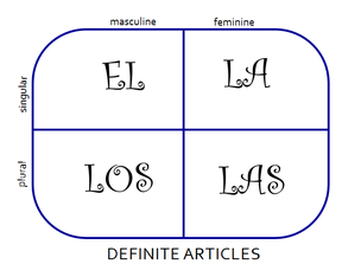An article is a word used to modify, to point out or to refer to a noun (a person, an object, an idea, a place, etc). Articles indicate the gender, number of a noun, and whether the noun is known to the reader/the listener. Just like in English, there are two types of articles in Spanish: definite and indefinite articles. In this lesson, we will learn about definite articles and find out what is a definite article and when to use definite articles “the” in Spanish.
Spanish definite articles
Definition
Definite articles are words used to talk about specific nouns or to indicate that the noun is known to the reader or the listener.
There are 4 forms of definite articles in Spanish: el, la, los, las. And of course, they often mean “the” in English. However, there are still times in Spanish that you use the definite article but you will NOT translate it to mean “the”.
| Singular | Plural | |
| Masculine | El | Los |
| Feminine | La | Las |
Examples:
el gato - the male cat
los gatos - the male cats
la gata - the female cat
las gatas - the female cats
Note:
- A definite article in Spanish must match both the gender (masculine or feminine) and number (singular or plural) of the noun it modifies.
Examples:
El libro está en el escritorio - The book is on the desk
La literatura española es muy interesante - Spanish literature is very interesting

4 forms of Spanish definite articles
Exceptions:
The masculine definite article should be used instead of the feminine definite one when a feminine singular noun begins with a stressed “a” or “ha” sound. However, when the same noun is plural, you should use the regular feminine article. The exceptions will be listed out below:
| Singular | Plural | English |
el águila | las águilas | the eagle(s) |
| el alma | las almas | the soul(s) |
| el agua | las aguas | the water(s) |
| el hacha | las hachas | the axe(s) |
Spanish definite articles and usage
When to use definite articles in Spanish?
1. To identify or to refer to a specific noun
Just like in English, in Spanish, you use definite articles to identify or to refer to a specific noun that has already been specified.
For example:
A mi papá le gusta poner la bandera grande mexicana afuera de la casa
My dad likes to put the big Mexican flag outside of the house
2. To express a concept or a general truth
For example:
A mi mamá no le gustaban los Estados Unidos; la vida aquí era muy difícil.
My mom didn’t like the United States; life here was very difficult.
3. To express likes or dislikes
Unlike in English, in Spanish, people use the definite article with verbs of preference like gustar, preferir, encantar, odiar.
For example:
Me gustan mucho los animales - I like animals a lot
4. Days of the week
In Spanish, definite articles are used with days of the week in Spanish, also to indicate habitual recurrence.
For example:
Los viernes nos pagaba según las horas que uno trabajaba - Fridays he paid us according to the hours one worked.
Follow our site for daily grammar, and vocabulary lessons.
